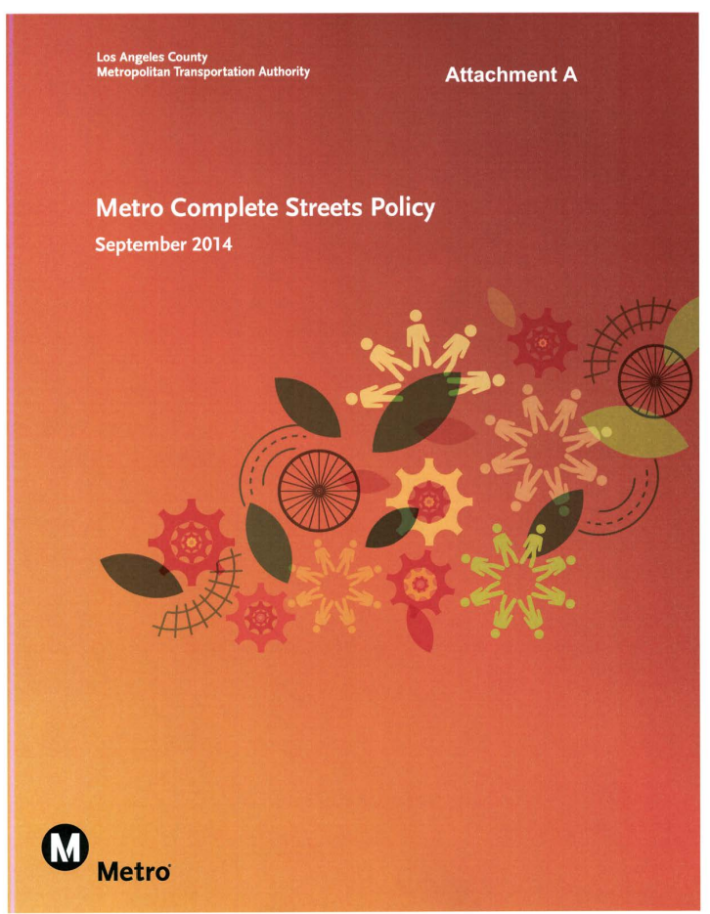Metro Moving Forward With Flawed Complete Streets Policy
2:33 PM PDT on October 15, 2014

At today's meeting, the Metro board of directors Ad Hoc Sustainability Committee approved the agency's proposed Complete Streets Policy [PDF]. The committee approval sends the policy to the full board for anticipated approval at its meeting next Thursday, October 23.
Complete streets policies, broadly, mandate that all streets need to accommodate people using all modes of travel, including walking, bicycling, transit, and driving.
Metro staff in giving their presentation [PDF], expressed that the bulk of regional complete streets implementation occurs outside Metro's jurisdiction. For the most part, street configurations are the jurisdiction of individual cities.
Metro staff identified two key areas where they assert that Metro has its greatest influence over complete streets implementation:
- Corridor Planning: Metro is a lead agency in building various projects, most prominently rail, but also highways and other facilities.
- Transportation Funding: Metro passes funding along to cities (and others) to build projects - including via the Call for Projects.
Seven public speakers, including L.A. County Bicycle Coalition's Eric Bruins and Safe Routes To School National Partnership's Jessica Meaney, expressed support for complete streets goals, and criticism of the draft policy. Comments focused on lack of enforceability, equity, performance metrics, as well as overall vagueness. For more details on criticisms expressed, read the Los Angeles County Active Transportation Collaborative comment letter at SRTS.
Sustainability committee members including Duarte City Councilmember John Fasana and L.A. City Councilmember Mike Bonin's Transportation Deputy Paul Backstrom portrayed the new policy as "a step in the right direction," while suggesting that some improvements will need to be made to it over time. The committee approved the policy, and requested that staff return later with proposed metrics.
In recent years, Metro has incorporated commendable complete streets facilities as part of some of its projects; examples include multi-use bike/walk paths along portions of the Metro Orange and Expo Lines. Though these bike and walk facilities are well-used, Metro does not include them in all projects, and tends to invest much greater funding in providing free parking for cars than it does in ensuring safe and convenient walking and bicycling access to its stations.
Metro recently adopted its First Last Mile Strategic Plan. Many Metro projects, though, continue to be rail- and car-focused, with first/last mile bike and pedestrian facilities being poorly-funded afterthoughts unevenly tacked on much later.
What's in Metro's proposed Complete Streets policy?
- The policy sketches out a commendable vision: "Complete Streets that provide safe, comfortable, and convenient travel along and across streets (including streets, roads, transit facilities, highways, bridges, and other portions of the transportation system) through a comprehensive, integrated transportation network that serves all categories of users, including pedestrians, users and operators of public transit, bicyclists, persons with disabilities, seniors, children, motorists, users of green modes, and movers of commercial goods."
- The vision is undermined by plenty of non-binding non-committal language. Examples include: "Metro is committed to considering all users..." and "These facilities should address the need for pedestrians and bicycles to cross..." (emphasis added).
- The policy outlines lots of vague exceptions. If policy compliance costs a lot, or has "environmental or social impacts," then it is acceptable to go with the past incomplete street approach.
- The exemption process is unclear. Contrast this with, say, a parking policy adopted by a city. When a proposed project fails to meet mandated parking requirements, the project is then subjected to an approval process for an exemption. In the absence of a clearly-defined exemption process, it appears doubtful that Metro will rigorously evaluate projects for complete streets policy compliance.
- The policy includes a Complete Streets Implementation Plan (pages 20-23) which lists a series of tasks that Metro will need to work with partners to complete. The list, unfortunately, does not identify what agency partners Metro will work with, nor even which Metro department is responsible for specified follow-through.
The Metro Complete Streets Policy could be critical (or might just be Completely ignored, pun intended) as current discussions shape a possible future sales tax proposal, and Metro's upcoming capital programs and Call for Projects. The Metro Complete Streets Policy policy will be considered by the full board next week.
Stay in touch
Sign up for our free newsletter
More from Streetsblog Los Angeles
Automated Enforcement Coming Soon to a Bus Lane Near You
Metro is already installing and testing on-bus cameras. Soon comes outreach, then warning tickets. Wilshire/5th/6th and La Brea will be the first bus routes in the bus lane enforcement program.
Metro Looks to Approve Torrance C Line Extension Alignment
Selecting the relatively low-cost hybrid alternative should help the oft-delayed South Bay C Line extension move a step closer to reality




